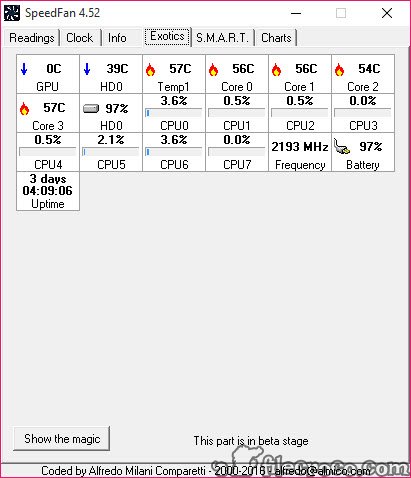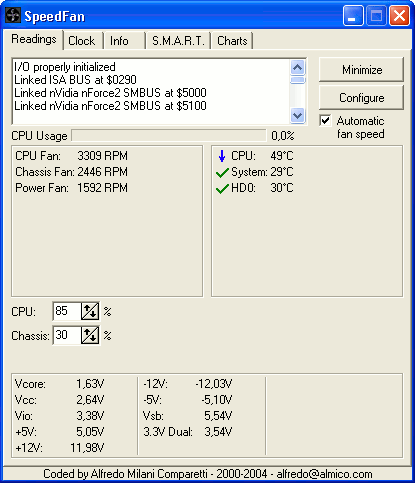




My motherboard (Asus Q-fan) fan speed control is off in BIOS with software removed(or disabled). What this is altering is the voltage from the motherboard via the IT8712F chip so the base voltage for the AMD fan is turned lower. I managed to find my configuration for this Speedfan version for my Asus A8N-SLI Premium and altered the CPU to 50%. Not only is the minimum speed 3000RPM which is quite high, but it can NOT be turned off and it causes problems when used with the motherboard fan speed control. SpeedFan can find almost any hardware monitor chip connected to the 2-wire SMBus Serial Interface and to the ISA BUS.The new AMD HSF (heatsink/fan) has a built-in fan speed controller. The most used are National PC87366 and all of SMSC LPC SuperIO chips. SpeedFan can automatically detect them and use their features. Some SuperIO chips include temperature sensors too. Winbond W83697HF, Analog Devices ADT7463, SMSC EMC6D102, ITE IT8712F, National LM85C and Maxim MAX6650 are very good candidates. If your BIOS was programmed to setup such chips this way you can still try to use SpeedFan's Advanced Configuration to revert to manual (software controlled) mode. Some chips can even be programmed to vary fan speeds without any additional software intervention. From one of the very first hardware monitor chips that could be found in standard PCs, the National Semiconductor LM75 (and all of its clones, like the Philips NE1617 and the Philips NE1618 or the Maxim MAX1617) or the Analog Devices ADM1021, such chips have been greatly improved, both in their precision and in their capabilities.Ĭurrent chips can monitor fan speeds, voltages and control fan speeds by using PWMs (Pulse Width Modulation). Several sensors, like Winbond's and the AS99127F support fan speed changing, as well as others from Maxim, Myson, Analog Devices, National Semiconductor and ITE, but the hardware manufacturer must have connected the relevant pins to some additional, yet trivial, circuitry. It works on Windows 64-bit versions, too. SpeedFan works with Windows 9x, ME, NT, 2000, 2003, XP, Vista, Windows 7, 2008, Windows 8, Windows 10 and Windows Server 2012. SpeedFan can change the FSB on some hardware (but this should be considered a bonus feature). info for hard disks that support it and show hard disk temperatures, too, when supported. By properly configuring SpeedFan, you can let it change fan speeds based on system temperatures. SpeedFan monitor temperatures from several sources. SpeedFan is a hardware monitor software that can access temperature sensors, but its main feature is that it can control fan speeds - depending on the capabilities of your sensor chip and your hardware - according to the temperatures inside your PC, thus reducing noise and power consumption.


 0 kommentar(er)
0 kommentar(er)
